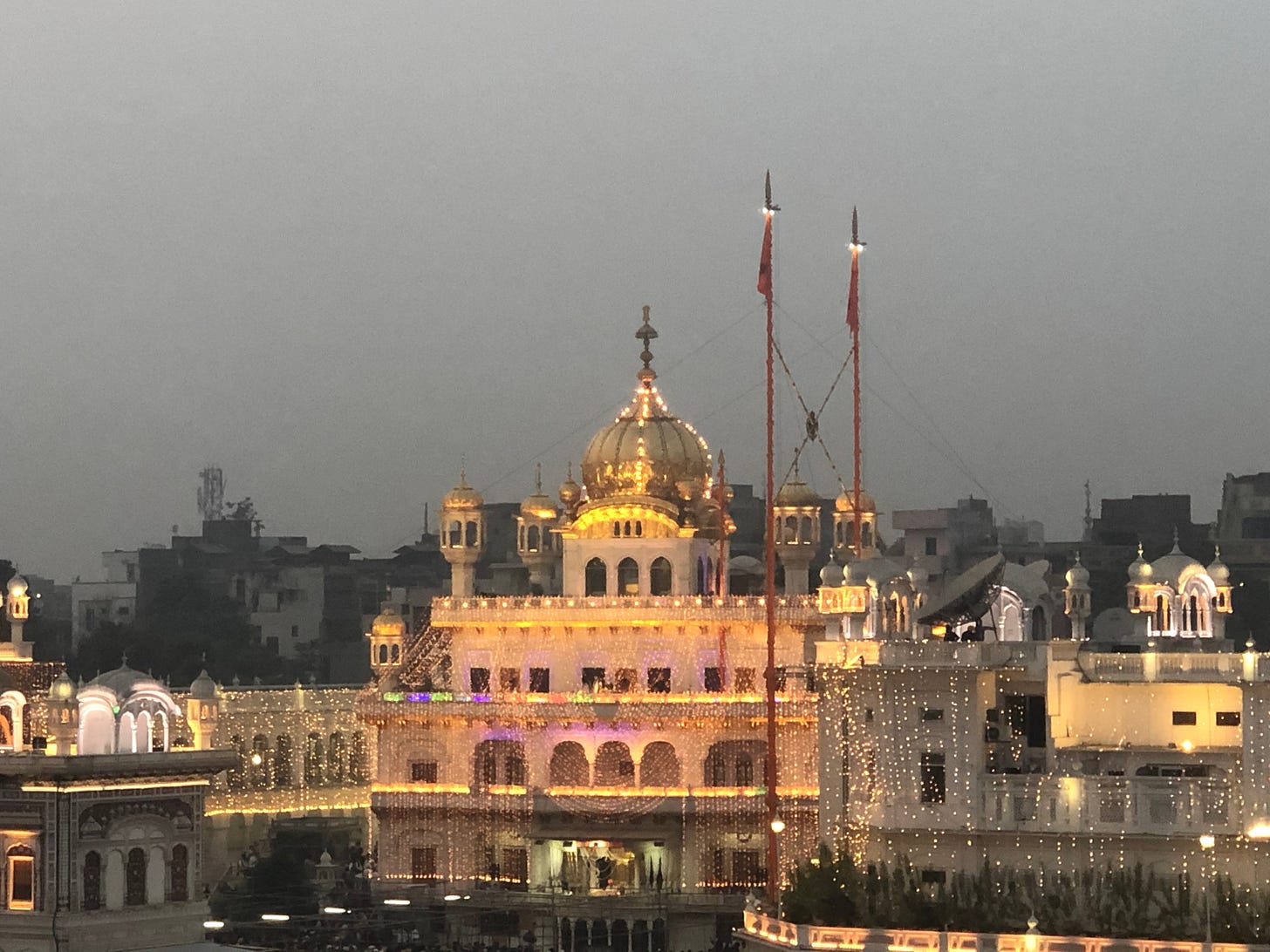"ਪੂਤਾ ਮਾਤਾ ਕੀ ਆਸੀਸ ॥" (Poota Mata Ki Asees)
A Mother's Timeless Blessing— flowing out the divine pen of Guru Arjan Dev ji in Raag Gujri.
A Mother's Timeless Blessing: An Exploration of "Poota Mata Ki Asees"
In the pantheon of human emotions and relationships, none perhaps is as universally cherished as the love between a mother and her child. In Sikh tradition, this sublime bond finds its most eloquent expression in the verses composed by Guru Arjan Dev Ji. These verses, set in the deeply evocative Raag Gujri, are part of the Guru Granth Sahib Ji and appear on Ang 496.
Before delving into the timeless wisdom of these lines, it is significant to note the title, "ਪੂਤਾ ਮਾਤਾ ਕੀ ਆਸੀਸ ॥" ("Poota Mata Ki Asees"). While "ਪੂਤਾ" translates literally as 'son,' the blessing and wishes encapsulated in these lines are universally applicable to a mother's love for her child, irrespective of gender.
The profundity and universality of these blessings are such that any discerning individual would recognize their applicability beyond the boundaries of religious faith. While they undoubtedly hold a special place for Sikhs, being part of their living Guru, the Guru Granth Sahib Ji, these words have the power to resonate with people from all walks of life.
So, as we delve into these lines, woven into the rich tapestry of Raag Gujri's notes, melodies, and tones, we encounter a mother's timeless aspirations for her child — a spiritual and ethical guide that transcends cultural or religious boundaries.
About Raag Gujri
The verses are set in Raag Gujri, an emotive musical measure that captures the essence of deep longing, devotion, and inner reflection. In Sikh tradition, Raags aren't merely musical scales but spiritual platforms that aid in the elevation of the soul. Raag Gujri is considered to be one of the more serious raags, often used for hymns that reflect on life's deeper questions and the nature of the human condition. Its melody is designed to facilitate a meditative state, allowing for greater absorption of the text's divine message. As per the tradition, the verses should ideally be sung in the form of kirtan, using the melodic patterns of Raag Gujri, to fully experience their emotional and spiritual depth.
An Exploration of Spiritual Wisdom: Reflecting on Guru Arjan Dev's Teachings
As we embark on this spiritual journey, it's noteworthy that the "shabad" is commonly known by its resounding refrain, "ਪੂਤਾ ਮਾਤਾ ਕੀ ਆਸੀਸ ॥" (Poota Mata Ki Asees). While this encapsulates the essence, the real depth of this divine composition unfolds in the subsequent verses. Each verse consists of two interconnected lines that we will explore collectively, in a modest effort to understand their profound implications.
First Verse
ਜਿਸੁ ਸਿਮਰਤ ਸਭਿ ਕਿਲਵਿਖ ਨਾਸਹਿ ਪਿਤਰੀ ਹੋਇ ਉਧਾਰੋ ॥
(Jis simrat sabh kilvikh nasah pitri hoe udharo)
"Remembering Him, all sins are erased, and ones generations, including the previous ones, are saved."
ਸੋ ਹਰਿ ਹਰਿ ਤੁਮ੍ਹ੍ਹ ਸਦ ਹੀ ਜਾਪਹੁ ਜਾ ਕਾ ਅੰਤੁ ਨ ਪਾਰੋ ॥੧॥
(So har har tumh sad hi japahu ja ka ant na paro)
"So meditate continually on the Lord, Har, Har; He has no end or limitation or boundaries."
The depth of Guru Arjan Dev Ji's composition in this "shabad" is truly remarkable, for it seems as if the Guru is channeling the voice of a devoted mother, articulating her profound blessings for her child. The couplet is more than a mere set of guidelines; it represents a spiritual vision that the mother wants to imbue in her child's life. She urges not just for worldly success but for a higher form of prosperity—that of continuous spiritual engagement. It underlines the notion that spirituality isn't a solitary pursuit but a collective endeavour that transcends the individual to bless the lineage past, present, and future. This sense of collective well-being and interconnected spirituality serves as the bedrock of the family's ethical and spiritual framework.
In doing so, Guru Arjan Dev Ji elevates the voice of the mother to a universal call for ethical living and spiritual striving, making it resonate with individuals across cultures and religions.
Second Verse
ਪੂਤਾ ਮਾਤਾ ਕੀ ਆਸੀਸ ॥
(Poota mata ki asees)
"O son, this is your mother's hope and prayer,"
ਨਿਮਖ ਨ ਬਿਸਰਉ ਤੁਮ੍ਹ੍ਹ ਕਉ ਹਰਿ ਹਰਿ ਸਦਾ ਭਜਹੁ ਜਗਦੀਸ ॥੧॥ ਰਹਾਉ ॥
(Nimakh na bisarau tumh kau har har sada bhajahu jagdees)
"That you may never forget the Lord, Har, Har, even for an instant. May you ever resonate with the Lord of the Universe."
In this lynchpin verse of the "shabad," Guru Arjan Dev Ji captures the quintessence of a mother's deepest aspirations and blessings for her child. More than a fleeting wish, it's a timeless incantation that aims to guide the child throughout their life journey. The mother's appeal isn't merely for material well-being or academic achievements; it's a soulful yearning for her child to remain in ceaseless communion with the Divine, the "Lord of the Universe."
The verse serves as a central axis around which the entire "shabad" revolves, emphasising the significance of spiritual remembrance as the ultimate form of wealth and well-being. "May you ever resonate with the Lord" transcends a mere request to an urging for constant spiritual attunement, a state of being where one is so deeply rooted in divine consciousness that worldly distractions can no longer waver the spirit.
It's a clarion call, not just to the child but to all of humanity, to anchor themselves in a state of ceaseless contemplation of the Divine. Here, the voice of the mother becomes a universal voice, symbolizing the collective hopes and prayers of mothers everywhere. This epitomizes the limitless scope and universal relevance of Guru Arjan Dev Ji's sacred verses.
Third Verse
ਸਤਿਗੁਰੁ ਤੁਮ੍ਹ੍ਹ ਕਉ ਹੋਇ ਦਇਆਲਾ ਸੰਤਸੰਗਿ ਤੇਰੀ ਪ੍ਰੀਤਿ ॥
(Satguru tumh kau hoe dayala santasang teri preet)
"May the True Guru be kind to you, and may you love the Society of the Saints."
ਕਾਪੜੁ ਪਤਿ ਪਰਮੇਸਰੁ ਰਾਖੀ ਭੋਜਨੁ ਕੀਰਤਨੁ ਨੀਤਿ ॥੨॥
Kapar pat parameswar rakhi bhojan kirtan neet
"May the preservation of your honor by the Transcendent Lord be your clothes, and may the singing of His Praises be your spiritual food."
In these evocative lines, Guru Arjan Dev Ji unfurls the spiritual tapestry that he wishes each child to be enveloped in. The verse extends the mother's prayer, urging the child to find both mentorship and companionship in the "Satguru" and the community of saints. The True Guru's kindness is sought not as an abstract notion but as a tangible force that transforms life, guiding the child in all spiritual and ethical endeavours.
The verse ingeniously equates spiritual practices with life's basic needs: clothing and food. "May the preservation of your honor by the Transcendent Lord be your clothes," encapsulates the idea that one's true dignity is maintained not through worldly adornments but by being in the grace and favor of the Almighty. Likewise, the phrase "may the singing of His Praises be your spiritual food ," resonates with the quintessential Sikh practice of Kirtan, articulating the notion that spiritual sustenance is as vital as physical nourishment.
The emphasis on "santasang" or the "company of saints" drives home the point that spirituality need not necessarily be a solitary endeavour. Rather, it thrives in a community of like-minded souls, each aiding the other in their quest for divine connection. The importance of satsang, or being in the company of the holy, has always been a cornerstone in Sikhism, reflecting the congregational aspect of the faith.
Through these lines, Guru Arjan Dev Ji ingeniously interweaves core Sikh values — the grace of the True Guru, the power of a spiritual community, and the importance of remembrance and praise of the Divine — into a mother's heartfelt blessings for her child. Thus, the verse serves as a microcosm of the larger spiritual universe that Sikhism inhabits, relevant not just to the mother and child but to anyone on a spiritual journey.
Fourth Verse
ਅੰਮ੍ਰਿਤੁ ਪੀਵਹੁ ਸਦਾ ਚਿਰੁ ਜੀਵਹੁ ਹਰਿ ਸਿਮਰਤ ਅਨਦ ਅਨੰਤਾ ॥
(Amrit peevhu sada chir jeevhu har simrat anad ananta)
"So drink in forever the Ambrosial Nectar; may you live long, and may the meditative remembrance of the Lord give you infinite delight."
ਰੰਗ ਤਮਾਸਾ ਪੂਰਨ ਆਸਾ ਕਬਹਿ ਨ ਬਿਆਪੈ ਚਿੰਤਾ ॥੩॥
(Rang tamasa puran asa kabehi na biapai chinta)
"May joy and pleasure be yours; may your hopes be fulfilled, and may you never be troubled by worries."
In these lines, Guru Arjan Dev Ji not only advances the spiritual narrative but also captures the essence of joyous living, thus delineating the ‘Sikhi’ way of life. The phrase "So drink in forever the Ambrosial Nectar; may you live long" encapsulates the idea that spirituality is deeply enmeshed with the earthly experience. The Guru's instruction to drink the Ambrosial Nectar is not a call for ascetic withdrawal but an invitation to engage fully in life’s sacred dimensions.
The concept of "Har simrat anad ananta" suggests that remembrance of the Divine brings boundless joy, reinforcing the idea that spiritual pursuit is not about disengagement from life but a way to find eternal happiness in it. Sikhism does not call for renunciation; instead, it advocates a life of a 'Karmayogi,' where one remains engrossed in their familial and societal duties even while keeping a constant connection with the Divine.
The lines "May joy and pleasure be yours; may your hopes be fulfilled, and may you never be troubled by worries" reiterate that the Sikh pathway is not merely about enduring life's hardships but about living it with elation and hope. The Guru’s aspiration here is comprehensive, wishing for a life where one's hopes and desires are fulfilled while staying unburdened by the worries that often plague the human mind.
In this nuanced way, Guru Arjan Dev Ji crafts a vision of life that is at once spiritual and joyously practical. He reaffirms the core Sikh philosophy that one does not need to renounce the world to be spiritual. Rather, one can find the Divine in the very act of living, thus fulfilling both spiritual and worldly responsibilities.
The Last Verse
ਭਵਰੁ ਤੁਮ੍ਹ੍ਹਾਰਾ ਇਹੁ ਮਨੁ ਹੋਵੋ ਹਰਿ ਚਰਣਾ ਹੋਹੁ ਕਉਲਾ ॥
(Bhavar tumhara ihu manu hovo har charna hohu kaunla)
"May this mind of yours be the bumble bee, and may the Lord's lotus feet be the flower."
ਨਾਨਕ ਦਾਸੁ ਉਨ ਸੰਗਿ ਲਪਟਿਓ ਜਿਉ ਬੂੰਦਹ ਲਪਟਿਓ ਜਲਿ ॥੪॥੧॥
(Naanak daas un sang lapatiyo jio boondah lapatiyo jal.)
Says servant Nanak, attach your mind to them, and blossom forth like the songbird, upon finding the raindrop.
The metaphors presented in these verses are deeply evocative, allowing for an intimate understanding of one's relationship with the Divine. The imagery of the bumble bee and the lotus is a classic representation, often used in ancient Indian scriptures to symbolize the soul's yearning for the Divine. The lotus, a recurrent symbol, is hailed for its purity and divinity, growing in muddy waters yet untouched by its impurities. Just like the bumble bee is irresistibly drawn to the nectar of the lotus, Guru Arjan Dev Ji encourages us to have our minds—our very beings—gravitate naturally and devotedly toward the lotus feet of the Lord.
In the phrase "Naanak daas un sang lapatiyo," the term "lapatiyo" moves beyond mere attachment—it implies a heartfelt embrace. Guru Sahib, speaking through the voice of the mother, isn't suggesting just a passive or ritualistic attachment to God. He is urging for an all-encompassing, passionate embrace of the Divine essence. Just like a songbird bursts spontaneously into melody upon embracing a raindrop, our souls too should chant the infinite praises upon uniting with the Divine.
Thus, Guru Arjan Dev Ji, via the mother's voice, isn't merely outlining a religious framework but is essentially guiding one towards a deeply personal, almost romantic, relationship with the Divine. A connection so profound, it transcends religious rituals and enters the realm of soulful yearning and eternal love.
Summing it all up
In wrapping up our humble interpretation of this soul-stirring "shabad," one cannot overlook its manifold layers of meaning and significance. The Guru, speaking through the loving voice of a mother, is not just imparting wisdom to her child, but to each one of us, offering life principles that wed worldly engagement with deep spiritual commitment. The teaching eschews ascetic withdrawal from the world, encouraging instead a full, vigorous, and meaningful life. At its core, it is a teaching of balance—of enjoying the world's offerings without becoming ensnared in the web of material illusion ("Maya Jaal").
Universal appeal
The Guru's message is not one of renunciation but of harmonious integration, embodying the qualities of a 'Karmayogi'—who lives fully, yet responsibly, enjoying familial and societal obligations while remaining steadfast in spiritual devotion. The wisdom encapsulated in this "shabad" is not confined to the domain of Sikhism; it transcends religious boundaries. It speaks to a universal truth applicable to all faiths and beliefs—that in the delicate balance between earthly living and spiritual aspiration, one finds the true essence of a fulfilling life. Therefore, as we ponder upon each verse, we are not just reading a religious hymn but engaging with a spiritual and ethical guidebook that has universal relevance
..
REQUEST: If you enjoyed this article from 'The KBS Chronicle', we encourage you to share it with others who might also find it valuable.
Click the link below to access easy sharing options for Twitter, Facebook, and Email. The same link also generates a web-link that can be shared via messaging apps like WhatsApp, Telegram, or Signal, in both individual and group settings.
Thank you for your support.
======================
Photos, unless otherwise stated, have been clicked by the author.
.













I love this shabad, and thank you KBS for delving into the depths and highlighting Guru ji’s message guiding us to live spiritually consciously and thus blissfully while pursuing our worldly challenges.
Very befitting write up on the relationship of son and mother every verse of gurbani teaches us the practical ways of life.. The important thing is, what ever gurus said, they lived it in thier lives sidhu sahib has taken the issue very deeply and thoroughly . 👏👏👏